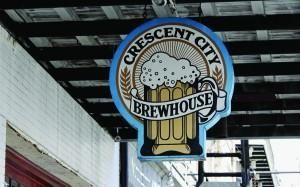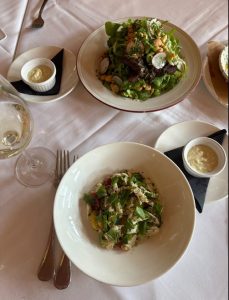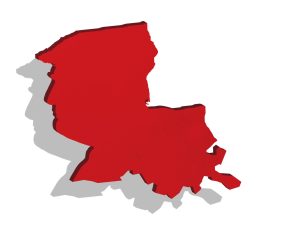No headline provided

October 20, 2011
New Orleans’ relationship with beer
For a city so stereotypically associated with alcohol, New Orleans isn’t particularly known for its beer culture. In the 19th century, however, that was not the case. New Orleans was the beer capital of the South with more than 30 breweries. But during the last 200 years, New Orleans beer culture has dwindled. Dixie was the last remaining large-volume brewery within city limits, before it stopped production in New Orleans after Hurricane Katrina. In a 2008 Brewers Association census, Louisiana was ranked 50 out of 51 U.S. states and territories in breweries per capita – a statistic that Jeremy Labadie, beer aficionado and author of the Beer Buddha blog, calls “staggering.”
Prohibition and the rise of huge national brands took a toll on New Orleans breweries. Only in recent history has craft beer resurrected the city’s beer heritage. Abita launched in 1986 and has dominated the Louisiana beer scene ever since. During the last few years, however, more and more craft beers have shown up on local taps. A married couple developed Lazy Magnolia beer in their Kiln, Miss. home in the early 2000s, and their Southern Pecan brew evolved into the unofficial craft beer of Mississippi. New Orleans Lagers and Ales, or NOLA Brewing Co., became the only brewery in New Orleans when the company was established in 2008, releasing its first beers in March 2009. Covington’s Heiner Brau microbrewery opened in 2005, and with NOLA Brewery’s founding, a trend began. In 2009, the Louisiana craft beer movement reached Cajun country with the creation of Parish Brewing in Lafayette and Bayou Teche in Arnaudville, La.
The resurgence of the city’s beer culture has, in the typical New Orleans fashion, been accompanied by a number of festivals celebrating the phenomenon. The Bulldog and the LA/SPCA hosted the second annual New Orleans on Tap Oct. 1, a free festival in City Park with more than 200 types of beer starting at $1 per sample. On March 19, Abita will host its second Top of the Hops beer festival at Fontainebleau State Park in Mandeville, featuring live music and 150 plus craft beers. Finally, every May, nearly 40 New Orleans area pubs and bars celebrate American Craft Beer Week, allowing locals to taste more than 100 different beers from around the nation. This yearly influx of micro brews and the growing popularity of establishments like the Avenue Pub – which exclusively serves craft beers – suggests that even more new draughts will likely join the local craft beer scene in the future.
-Christina Murphy
Abita Brewing Company
There is no brewery that screams Louisiana like the Abita Brewing Company. Two home brewers who wanted to turn their hobby into a career founded the Abita Springs Brewery in 1986. The brewery continues to be privately owned and locally operated. It is the oldest craft brewery in the Southeast and has grown from producing 1,500 barrels of beer to more than 100,000 barrels per year. It still maintains its small-brewery taste, with all batches hand-crafted by brewmaster Mark Wilson and his dedicated team.
Abita takes great pride in its quality ingredients, including the pure artesian water from its deep wells in Abita Springs.
“A lot of people are familiar with Abita Springs water, but most don’t know that the chemical make-up of the water is perfect for making beer,” Abita Brewing Company president David Blossman said. “It goes straight from our wells, without having to treat or add anything.”
You’ll never find anything artificial in an Abita bottle. The brewery produces seven year-round brews, as well as five seasonal, three harvest and four “big beer” brews, such as Andygator, Save Our Shores and Abbey Ale.
The Strawberry Harvest brew is a local favorite with its crisp, fresh taste that is crafted with a hint of strawberries. The beer causes a yearly frenzy, with every drinker in a mad race to stock up.
This time of year lends itself to two of Abita’s seasonal brews: Fall Fest and Pecan Harvest. Fall Fest is a Marzen-style Octoberfest lager, brewed with German Haullertau hops and only available from September to November each year. Abita’s Pecan Harvest Ale is made with Louisiana pecans, giving it a nutty flavor and aroma. The results are two beautiful brews, perfect for this season’s changing weather.
Blossman said that Pecan Harvest and Fall Fest have sold so quickly this year that the Christmas Ale will be hitting the shelves next week. Christmas Ale is Abita’s holiday present to us all, with a recipe that changes every year.
Abita graciously caters to those under 21 with a non-alcoholic beverage. Its Root Beer is crafted with herbs, yucca, vanilla and Louisiana cane sugar, packaged in the traditional Abita bottles.
The brewery’s doors are open for visitors, with weekly tours available Wednesday through Saturday. The tour begins and ends in its Tasting Room, a treat that the 20,000 annual vistors won’t soon forget.
“One of the best parts is that it’s free, and you get to learn more about what we do,” Blossman said. “We think it’s educational, but it’s also a lot of fun. We try to keep it that way. A lot of the beers are on tap to sample.”
-Amy Garner
Gnarly Barley
Zac Caramonta has been a beer enthusiast for as long as he can remember. After years of industrious drinking and a beer tour around Europe, he figured that he might as well give the ancient science a shot. He and his wife Cari bought a home brewing kit and in the last several years have built a good-sized operation – Gnarly Barley Brewery – in their Ponchatoula, La. home.
“For the past few years I’ve pretty much been obsessed with brewing,” Caramonta said.
Currently, the brewery produces two main beers – Lazy I.P.A. and Korova Coffee Porter. The latter, a rich and sweet dark beer, is named both for the iconic Korova Milk Bar in Stanley Kubrick’s “A Clockwork Orange” as well as the Russian word for “cow.” The porter is made with unfermentable lactose sugar, which gives it a creamy, dessert-like quality. Though other beers are still in the works, Caramonta also hopes to release several seasonal brews in the next year.
Both the I.P.A. and the porter premiered at the NOLA On Tap beer festival Oct. 1. The Gnarly Barley crew – largely extended family members and close friends in matching red t-shirts – poured draught beer from tap handles made from shards of Caramonta’s old skateboards. Perhaps unprepared for the popularity of their product, it was one of the first tents to run out of beer and one of the most-discussed both at the festival and in reviews online.
Though all necessary permits and licenses are still pending, Gnarly Barley hopes to have 22-ounce bottles of its beer on local shelves by summer.
“The plan is to focus on the north shore for now and then expand into New Orleans if the demand allows for it,” Caramonta said. “We want to keep it small and focus on brewing the types of beer that we like to drink.”
-Zach Yanowitz
NOLA Brewing Co.
Beer enthusiasts were ecstatic when NOLA Brewing Co. announced its decision to start canning this fall. NOLA Brewing Co.’s locally-made beers, produced on Tchoupitoulas Street, are unlike any other. NOLA stands not for New Orleans but for New Orleans Lagers and Ales Brewing Company. NOLA offers eight different beers, from the original Blonde Ale and the Hopitoulas to their newest concoction, the Smoky Mary.
Launched in 2008 by veteran brewer Kirk Coco, NOLA Brewing Co was Coco’s attempt to make a uniquely New Orleanian beer after Hurricane Katrina forced Dixie Beer to move to Wisconsin. His original goal was to build a microbrewery that would make small batches of handcrafted beer, but the popularity pushed NOLA Brewing into making larger and larger batches. This year, the brewery has already made an estimated 2,500 barrels.
NOLA’s beers are not only hand-crafted but also hand-designed by a small group of locals. NOLA’s head brewer, Melanie Knepp, does the craft brewing for NOLA. Their brewmaster, Peter Caddoo, a former Dixie brewmaster, decided to stay in New Orleans after Katrina, and was instrumental in founding NOLA Brewing Co.
For years, the only way to buy NOLA beer was by the keg, but they’re releasing the first NOLA cans in January. If you can’t wait until then, NOLA Brewing is launching a Can Party Oct. 27 at Tipitina’s where $15 gets you tickets to see Colin Lake, Flow Tribe and Big Sam’s Funky Nation. But, more importantly to beer enthusiasts, it gets you a brand-new can of Blonde Ale.
-Nicole Nolan
Dixie Brewery
The Dixie Brewing Compnay set up shop in Mid City in 1907. Until Hurricane Katrina, Dixie was the only large-scale brewery operating within New Orleans city limits. After sustaining water damage from Katrina, the brewery was looted of almost all equipment. Now, the building stands abandoned in a zone that will be incorporated into a new hospital. Though Dixie beer is no longer brewed in town, it’s still a New Orleans staple. Joseph Huber Brewing brews Dixie and ships it nationwide out of Monroe, Wisc. You can find Dixie signs, with its old-school green and gold logo hanging off of bars around town. Miss Mae’s sports such a sign, and you can find six-packs at most grocery stores. Sold strictly in bottles, Dixie’s lager has a sweet, light taste – think beer mixed with a few tablespoons of cane sugar. This beverage is the perfect beer to bring to the Fly on a Friday afternoon.
-Sophie Unterman
Covington Brewhouse:
Nobody takes beer as seriously as Germans, so it only makes sense that New Orleans microbreweries should pay tribute to the 19th century German immigrants who transformed the city into the brewing capitol of the South. Located on the north shore of Lake Ponchatrain, Covington Brewhouse prides itself on brewing perfect-craft beer the good old-fashioned way. Its owner and brewmaster, “Heiner” Orlik of Heiner Brau Microbrewery, is one of the few German brewmasters left in the United States. His beers adhere strictly to the Germany Purity Law of 1516, which demands that no supplements, artificial carbonation or other additives be used in the brewing process.
Covington Brewhouse produces three seasonal beers: Pontchartrain Pilsner, a seafood-complimentary beer that is “refreshing as a gentle lake breeze;” Bayou Bock, a full-bodied lager; and Strawberry Ale, a cream ale brewed with Louisiana strawberries. The Strawberry Ale is a serious competitor for local favorite Abita Strawberry. In addition to the three seasonal beers, Covington also produces four seasonal brews, including an Oktoberfest brew. If you’re looking for some serious local beer, crack open a bottle from Covington Brewhouse, enjoy it with some seafood and thank the booze-gods that you live in New Orleans.
-Stephanie Chen
Tin Roof Brewing Company
Tin Roof Brewing Company, located in Baton Rouge, is the newest addition to the growing number of Louisiana breweries. The beer comes in two uniquely delicious varieties. For those who enjoy a hoppier brew, choose Voodoo Bengal Pale Ale for its honey and caramel flavors. The microbrewery also offers a milder option called Perfect Tin Amber. Since opening in November 2010, Tin Roof has been featured on tap at myriad locations in Baton Rouge and New Orleans. As one would expect, local beer haven The Bulldog carries Tin Roof at all its locations, but if you would rather stay close to campus, both The Boot and Bruno’s Bar and Restaurant have the brand new beer on tap as well. If bars aren’t your scene, you can also purchase cans of Tin Roof at Whole Foods and other grocery stores around town. Tin Roof Brewing Company, although in its infancy, is already making a foamy splash.
-Sam Abramowitz
Bayou Teche Biere
Bayou Teche Biere brews for one purpose: to craft beers that complement Cajun and Creole cuisine. The brewery, located an hour west of Baton Rouge in Arnaudville, La., boasts four different types of handcrafted beers. The brand was born in 2009 when an Arnaudville family transformed a discarded railroad car into a farmhouse brewery. Since then, the brewery’s beers have been distributed throughout South Louisiana. Each type of Bayou Teche’s beer has a unique flavor. Its Bi??re P??le, also known as Louisiana Pale Ale, is simply crafted for all things Creole. The brewers tweaked this type of beer to complement each and every traditional South Louisana dish. The brewery’s second type of beer, Boucan??e, is infused with handpicked smoked cherries and is crafted to complement barbeque’s smoky flavors. Bi??re Noire, perhaps the brewery’s most distinctive beer, was crafted to be paired with spicy foods – it has a French roasted coffee flavor and a bitter bite to it. Grenade is a bright yellow, citrus-flavored beer brewed with passion fruit. Next time you’re craving Creole food, keep Bayou Teche Biere in mind.
-Jamie Norwood
Crescent City Brewhouse
Aspiring alcohol aficionados and New Orleans history buffs would be remiss to not stop by the Crescent City Brewhouse on their next trip Downtown. It is the only microbrewery located in the French Quarter, and it operates on a property as old as the city itself. The property was first built on Decatur Street in the early 1700s. The Great New Orleans Fire of 1794 reduced the original building to ash, but it was quickly rebuilt into an upper-middle class home. The property changed hands many times during the next two centuries, and in 1991, the Crescent City Brewhouse opened on the site.
Crescent City has been recognized for both preserving the historical integrity of its property and for producing quality house brews. The four house specialties of the microbrewery are Pilsner, Red Stallion, Black Forest and Weiss Beer. These award-winning lagers are brewed in-house, and other world-class beers are also brewed in smaller quantities. The microbrewery also offers a fine menu of traditional New Orleans cuisine and live jazz every night. The Crescent City Brewhouse is the perfect place to become immersed in New Orleans culture, history and, obviously, fine beer.
-Lucy Stratton









Leave a Comment